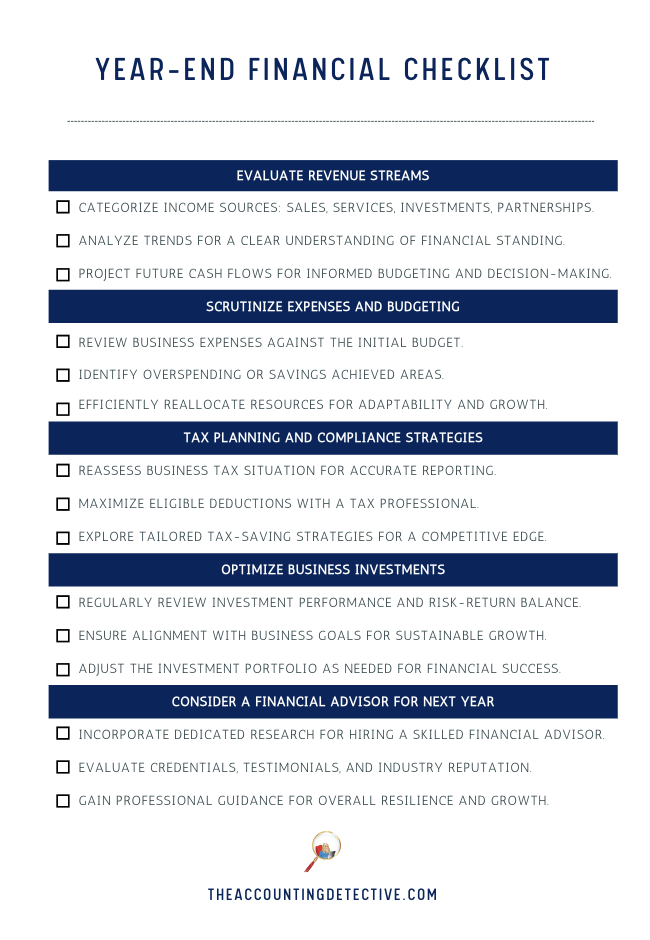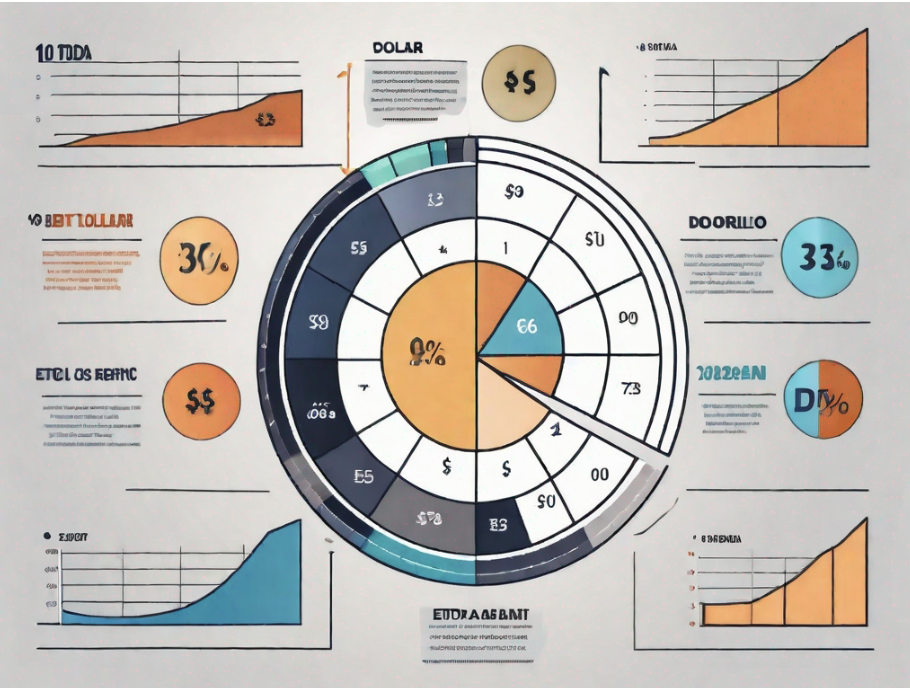Year-End Financial Checkup Guide for Startups and Small Business Owners
Year-End Financial Checkup Guide for Startups and Small Business Owners
Guide for small business owners: Optimize year-end finances with insights on revenue, expenses, taxes, and investments.

As the year draws to a close, small business owners are presented with a critical opportunity to assess and optimize their financial standing. The Year-End Financial Checkup Guide for Small Business Owners aims to provide practical insights to ensure that your business not only concludes the current year on a strong note but also lays the groundwork for a successful year ahead.

Evaluate Revenue Steams
Evaluate Revenue Steams
Embark on your financial checkup by closely examining your business’s revenue streams. From sales and services to investments and partnerships, categorize and analyze all sources of income. Understanding your business’s income dynamics aids in projecting future cash flows, enabling you to make informed decisions about budgeting and growth strategies.
By evaluating your revenue streams, you can gain a clear understanding of where your business stands financially. Start by categorizing your sources of income, such as sales, services, investments, and partnerships. This will help you see which areas are generating the most revenue and which ones may need improvement.
With a clear understanding of your revenue streams, you can then project future cash flows.
This is crucial for budgeting and planning purposes. By knowing how much money you can expect to come in, you can make informed decisions about expenses, investments, and growth strategies.
For example, if you notice that one particular revenue stream is consistently bringing in a significant amount of income, you may want to allocate more resources towards that area. On the other hand, if you find that a certain revenue stream is underperforming, you can explore ways to improve it or consider alternative sources of income.
The goal of evaluating your revenue streams is to optimize your business’s financial standing. By understanding where your income is coming from and how it may change in the future, you can make strategic decisions that will set your business up for success in the coming year.
Taking the time to evaluate your revenue streams is an essential part of the year-end financial checkup for small business owners. It provides valuable insights into your business’s financial health and helps you make informed decisions about budgeting and growth strategies. So, grab your financial statements, categorize your income sources, and start analyzing to ensure a strong financial foundation for the year ahead.

Scrutinize Expenses and Budgeting
Scrutinize Expenses and Budgeting
Dive into an in-depth review of your business expenses, comparing them against the budget set at the beginning of the year. Identify areas where costs exceeded projections or where savings were achieved. This scrutiny ensures efficient resource allocation, helping your small business adapt and thrive in the upcoming year.By scrutinizing your expenses and budgeting, you can gain a clearer understanding of where your money is going and identify any areas where you may be overspending.
This analysis allows you to make necessary adjustments and reallocate funds to more productive areas of your business. For example, if you find that you are spending too much on marketing with little return on investment, you can explore alternative marketing strategies or channels that may yield better results.
Additionally, reviewing your expenses and budgeting can help you identify any unnecessary or redundant costs that can be eliminated. This could include subscriptions or services that you no longer use or need. By cutting back on these expenses, you can free up valuable resources that can be reinvested into other aspects of your business, such as research and development or employee training.
Furthermore, this process allows you to assess the effectiveness of your budgeting strategies. If you consistently find that certain expenses are exceeding projections, it may be necessary to adjust your budget accordingly. On the other hand, if you consistently achieve savings in certain areas, you can consider allocating those funds towards growth initiatives or building up your emergency fund.
Ultimately, scrutinizing your expenses and budgeting is a crucial step in ensuring the financial stability and success of your small business. It provides you with the necessary insights to make informed decisions, adapt to changing market conditions, and position your business for growth in the year ahead. So, take the time to evaluate your revenue streams, analyze your expenses, and make the necessary adjustments to set your business on the path to financial prosperity.
Tax Planning and Compliance Strategies
Tax Planning and Compliance Strategies
With tax season on the horizon, now is the ideal time to reassess your business’s tax situation. Ensure accurate reporting of all income sources, maximize eligible deductions, and stay compliant with tax regulations. Collaborate with a tax professional to explore tax-saving strategies tailored to your small business, providing a financial edge in the competitive landscape.
Tax planning and compliance strategies are crucial for small businesses to navigate the complex world of taxes. By reassessing your business’s tax situation, you can ensure accurate reporting of all income sources and maximize eligible deductions. This not only helps you stay compliant with tax regulations but also provides a financial edge in the competitive landscape.
Collaborating with a tax professional is highly recommended during this process. They have the expertise and knowledge to guide you through the intricacies of tax planning and compliance. They can help you identify tax-saving strategies that are tailored specifically to your small business.
One important aspect of tax planning is evaluating your revenue streams. By analyzing your income sources, you can identify areas where you may be able to reduce your tax liability. This could involve exploring deductions and credits that you may be eligible for, such as those related to business expenses, equipment purchases, or research and development.
On the other hand, it is equally important to analyze your expenses. By carefully reviewing your expenses, you can identify areas where you may be overspending or where you can make cost-saving adjustments. This could involve renegotiating contracts with suppliers, finding more cost-effective alternatives, or implementing efficiency measures within your business operations.
Making the necessary adjustments based on your revenue streams and expenses will set your business on the path to financial prosperity. It allows you to optimize your tax situation, minimize unnecessary expenses, and ultimately increase your bottom line.
In addition to tax planning, staying compliant with tax regulations is crucial. Failing to do so can result in penalties, fines, or even legal consequences.
By collaborating with a tax professional, you can ensure that your business is following all the necessary rules and regulations. They can help you navigate the ever-changing tax landscape and keep you updated on any new laws or regulations that may affect your business.
Tax planning and compliance strategies are essential for small businesses. By reassessing your tax situation, collaborating with a tax professional, and making the necessary adjustments, you can position your business for growth and financial success in the year ahead. Therefore, it is essential to take the time to evaluate your revenue streams, analyze your expenses, and make the necessary tax-saving adjustments. Your business will thank you for it.

Optimize Business Investments
Optimize Business Investments
Devote attention to analyzing your small business’s investment portfolio. Evaluate the performance of investments, gauge the risk-return balance, and realign your portfolio if needed. Consider whether your investment strategy aligns with your business goals and adjust to position your company for sustainable growth. One important aspect of optimizing your business investments is to regularly review the performance of your current investments. This involves analyzing the returns you are receiving and comparing them to the level of risk you are taking. By doing so, you can determine if your investments are generating the desired results and if any adjustments need to be made.
In addition to evaluating the performance of your investments, it is crucial to assess the risk-return balance. This means considering the level of risk you are comfortable with and ensuring that it aligns with the potential returns you expect. If you find that your investments are too risky for the returns they are generating, it may be necessary to realign your portfolio.
Furthermore, it is essential to ensure that your investment strategy aligns with your business goals. Take the time to evaluate whether your current investments are contributing to the growth and success of your company. If not, it may be necessary to make adjustments to your investment strategy to better position your business for sustainable growth.
By devoting attention to analyzing your small business’s investment portfolio and making the necessary adjustments, you can optimize your investments and increase the likelihood of achieving financial success. Remember, regularly reassessing your investments and aligning them with your business goals is a crucial step in positioning your company for long-term growth.
Consider a Financial Advisor for next year.
Consider a Financial Advisor for next year.
In addition to the essential components of your year-end financial checklist, consider incorporating a dedicated research phase into your plan, focusing on hiring a financial advisor for your company. A skilled financial advisor brings expertise in strategic financial planning, investment guidance, and risk management.
Conduct thorough research to identify potential candidates, reviewing their credentials, client testimonials, and industry reputation. Engaging a financial advisor can provide invaluable insights, ensuring that your business is well-positioned for success in the upcoming year.
This proactive step adds a layer of professional guidance to your year-end financial preparations, contributing to the overall resilience and growth of your company.

Conclusion
In summary, the Year-End Financial Checkup Guide for Small Business Owners is an invaluable resource for navigating the complexities of year-end financial management. By strategically assessing revenue, scrutinizing expenses, optimizing tax strategies, and refining investment portfolios, small business owners can fortify their financial foundations.
As you embark on this financial checkup, we invite you to share your experiences and insights in the comments section below. How has this guide impacted your small business? What specific financial challenges are you facing?
It All Starts With a FREE consultation!
Every client’s needs are unique and require varying amounts of time and attention. You can use this form to let us know what you’re looking for, and we’ll reach out to you to schedule an appointment and talk about rates for your business needs.
Please be as detailed as possible with what work is needed, what industry your business is in, and where you are located.
Our team will contact you with in 2 business days to set up the first meeting. We will make sure all your needs are taken into account when selecting the package and type of services you need.






Stay In Touch